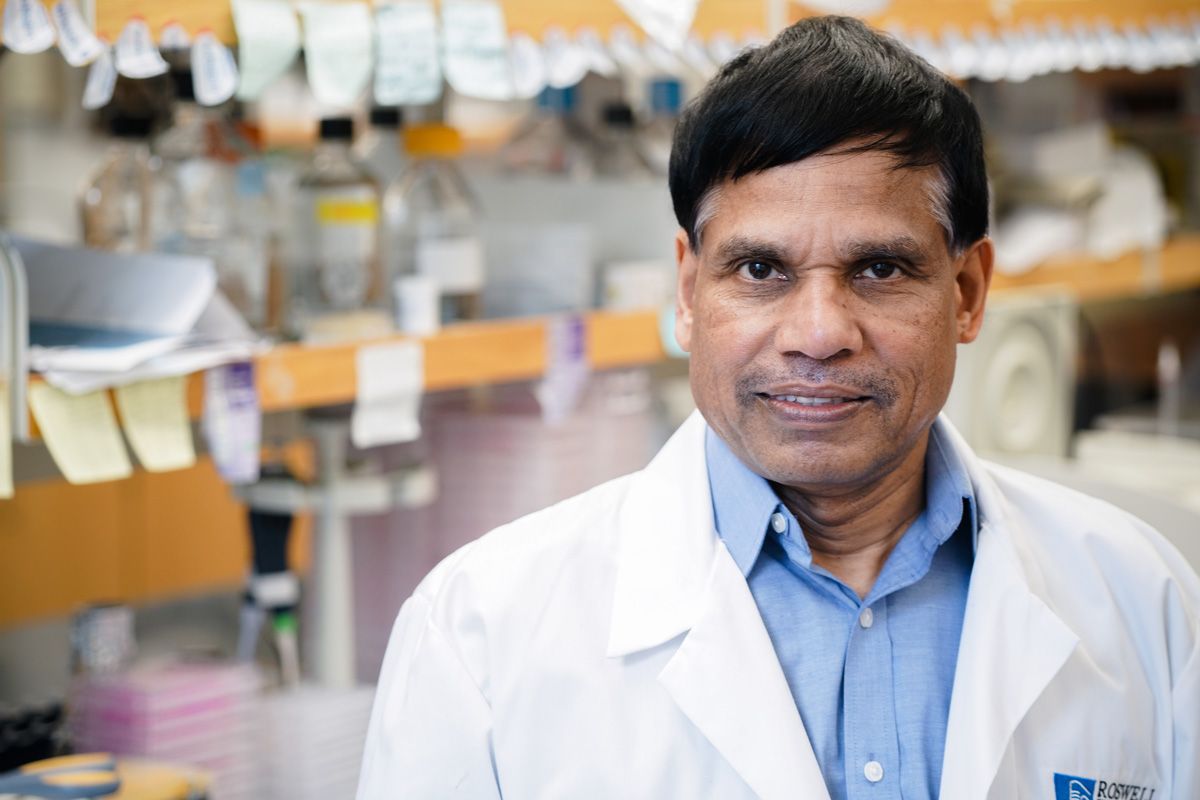Roswell Park’s innovations represent a range of opportunities with the potential to impact patients with all types of cancer.
Learn moreTreatment of HER2-Positive Cancers with Prolidase
Breast cancer tumors that possess the human epidermal growth factor receptor-2 (HER-2) are called HER-2 positive cancers. These cancers can be invasive and spread rapidly if not detected early and treated with efficacious drugs. The HER-2 receptor, moreover, is the major target in 20-30% of all human breast cancers. Overexpression, amplification and activating-point mutations of the HER-2 family of receptors promotes the development of cancer cells, is associated with an aggressive clinical phenotype and remains a strong indicator of poor disease prognosis.
Drug resistance to current HER-2 inhibitors, such as the frontline therapy Herceptin®, is one of the major unresolved clinical problems that oncologists face today. In fact, approximately half of all breast cancer patients show primary or secondary resistance to Herceptin, among other treatments, for HER-2 positive breast cancer.
Human peptidase D (PEPD), i.e., prolidase, is a native enzyme found in all human cells, which has been shown to strongly inhibit HER-2 in breast cancer cells. As such, insofar as HER-2 remains overexpressed in drug-resistant breast cancer cells, the present technology is directed towards an enzymatically inactive, recombinant form of PEPD that is able to overcome Herceptin resistance via its interaction with the HER-2 receptor.
Antibody-Derived T Cell Therapeutics Targeting Ideal Cancer Antigens
Chimeric antigen receptor T-cell (CAR-T) therapies have revolutionized the fight against hard-to-treat liquid tumors, weaponizing a patient’s own immune system to fight certain cancers. The next phase in this development is to create and advance CAR-T treatment to be effective against solid tumors, which are prone to fighting against most types of treatment and can trick healthy cells to attack treatment as well. By combining multiple therapeutic platforms that employ single-chain variable fragments (SCVFs) from other antibodies that also target cancer cells and their support framework, it is possible to achieve a longer-lasting T-cell response. Further adapting T cells to secrete either bi-specific T-cell engagers (BiTEs), to convince healthy cells to fight against the tumor, or SCVFs, or both, it is possible to create an effective solid tumor treatment that builds on the success of CAR-T therapies. This will enable patients to receive targeted immunotherapy for solid tumors, something that has not yet been achieved anywhere.
Inhibiting Biosynthetic Pathways in Myeloid Cells Ameliorates their Suppressive Phenotype and Augments Responses to Immune Checkpoint Blockade
In the early stages of some cancers, including acute myeloid leukemia (AML) and breast and lung cancer, myeloid-derived suppressor cells can accumulate, leading to a poorer prognosis and resistance to immunotherapy treatments. By combining immunotherapy with Brequinar (BRQ), a compound that functions to enforce myeloid differentiation of AML, immune checkpoints are boosted and have better efficacy in fighting the cancer. Further, it’s possible that patients could receive the same amount of targeted treatment with fewer side effects, thereby improving their quality of life, or might be able to have smaller amounts of treatment with fewer side effects while the treatments are equally effective as a full dose. The combination of BQR and an immune checkpoint blockade creates a novel immunotherapy approach to treating solid cancers, inhibiting primary and metastatic tumor growth compared to treatment from either agent alone. The efficacy of this treatment has been affirmed on an existing molecule.
Exploiting the Estrogen Receptor Beta and TP53 Interaction As A Novel Therapeutic Strategy For Cancer
Inventor: Gokul Das, PhD
Currently, available targeted therapies for aggressive triple negative breast cancers (TNBC) are inadequate. These cancers are unresponsive to hormone modulation, and with the long-term ineffectiveness of cytotoxic chemotherapy, treatment options for patients are typically limited to surgical resection, radiation and highly toxic broad-spectrum chemotherapies. Accordingly, there is an urgent need to discover new therapeutic targets and strategies for treating TNBC.
The present technology addresses this need by first stratifying TNBC patients based on the mutagenic state of the tumor suppressor gene product, p53, i.e., the genomic gatekeeper, in combination with the expression level of estrogen receptor beta, ERb. In this respect, TNBC patients possessing a mutated p53 protein phenotype, while also expressing low levels of ERb, are selected for receiving a combination of tamoxifen and doxorubicin.
Specifically, when administered in combination with tamoxifen, doxorubicin can be administered at much lower doses than if provided to the patient as a monotherapy. Consequently, TNBC patients now have increased access to chemotherapies that may have been previously far too toxic to administer alone.
Targeting Glucose-Stimulated Phosphohistidine Signaling in Esophageal Cancer
Cancers that do not respond to growth factor inhibition therapy, e.g., tyrosine kinase inhibitors (TKIs), pose significant challenges for clinical oncologists. One such cancer is esophageal squamous cell carcinoma (ESCC). Although these tumors are genetically disparate, they all share a common metabolic weakness, i.e., their proliferation requires glucose. ESCC tumors, in this regard, are able to reprogram glucose metabolism to promote tumor growth in the absence of cellular growth factors. This reprogramming is achieved through the activity of focal adhesion kinase (FAK).
The present technology entails small molecule inhibitors that specifically interrupt the glucose-induced FAK signaling that drives ESCC growth. By directly binding to a critical pocket on FAK, these small molecules prevent glucose-stimulated tumor progression in patients possessing drug-resistant malignancies, while not impacting glucose uptake or metabolism in normal cells. Accordingly, this technology portends an innovative way to treat refractory ESCC.
